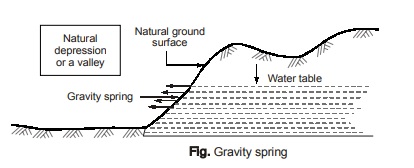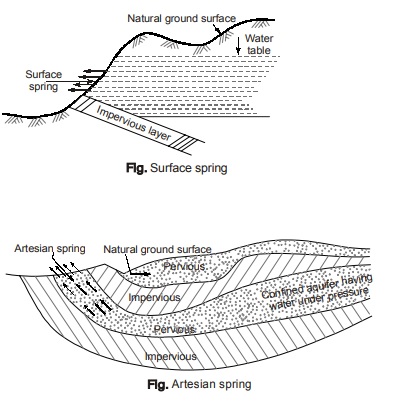Zones of Underground Water
Zones of Underground Water
With regard to existence of water at different depths in sub-surface regions, earth’s crust can be divided into various zones, namely.
GEOLOGICAL FORMATIONS
There are various types of geological formation that would exists below the earth’s surfaces but with regard to its water holding capacity (i.e. porosity) and its ability to allow the flow or water through interconnecting voids (i.e. yield), they are classified as:
(a) Aquifers
A permeable stratum or a geological formation of permeable material, which is capable of yielding appreciable quantities of ground water under gravity, is known as an aquifer. When an aquifer is overlain by a confined bed of impervious material, then this confined bed of impervious material is known as aquiclude. If a well is excavated through an aquifer, then amount of water yielded by it depends upon:
(i) Permeability of aquifer
(ii) Thickness of aquifer
(b) Aquifuge
The geological is that geological formation which is neither porous nor permeable and it neither contains nor yields ground water. Granite rock example of aquifuge.
(c) Aquitard
The geological formation which does not yield freely to wells due to its lesser permeability, although seepage is possible thought it. The yield from such a formation is thus insignificant. Sandy clay is an example of aquitard.
(d) Aquiclude
The geological formation which is highly porous, containing large quantities of water, but essential impervious, as not to yield water. A clay layer is an clay layer example of aquiclude.
Springs
The natural outflow of ground water at earth’s surface is said to form a spring:
A pervious layer sandwiched between two impervious layers, give rise to a natural spring. A spring indicates the outcropping of the water table. The springs are generally capable of supplying very small amounts of waters, and are, therefore, generally not regarded as sources of water supplies. However, good developed springs may sometimes be used as water supply source for small town especially in hilly areas.
(a) Formation and Types of Springs
Springs are usually formed under three general conditions of geological formation, as explained below:
(i) Gravity Springs
When the ground water table rises high and water overflow through the sides of a natural valley or a depression, the spring formed is known as gravity spring. The flow from such a spring varies with the rise or fall of the water table.

(ii) Surface springs 
Sometimes, an impervious obstruction or stratum supporting the underground storage becomes inclined (as shown in figure), causing the water table to go up and get exposed to the ground surface. This type of spring is known as
surface spring.
(iii) Artesian Springs
When the surface springs storage is under pressure i.e. under some confined aquifer, the spring formed is known as artesian spring. This type of spring are capable to provide almost uniform quantity of water. Since the water oozes out under pressure, they are able to provide higher yields and may be thought of as the possible sources of water supply.
Wells
A hole usually vertical, excavated in the earth for bringing ground water to the surface is called water well.
The wells may be classified into two types:
(a) Open wells
(b) Tube wells
(a) Open Wells or Dug Wells
Smaller amount of ground water has been utilised from ancient times by open wells. They are generally open masonry wells having comparatively bigger diameters and are suitable for low discharges. The yield of an open well is limited because such wells can be excavated only to a limited depth, where the ground water storage is also limited. Moreover, in such a well, water can be withdrawn at only critical velocity for soil. Higher velocity can’t be permitted as they may lead to disturbance of soil grains. This also puts limits on discharge of wells. One of the recent methods used to improve the yield of an open well is to put in a 8 to 10 cm diameter bore hole in the centre of the well, so as the tap the additional water from an aquifer, or from fissures in the rock. Open wells may be classified into the following two types.
(i) Shallow wells
(ii) Deep wells
A shallow well is the one which rests in a pervious strata and draws its supplies from the surrounding material. On the other hand, a deep well is the one which rests on an impervious ‘mota’ or “magasan” layer and draws its supply from the pervious formation lying below the mota layer, through a bore hole made into the mota layer.
YIELD OF AN OPEN WELL
The yield of an open well can be calculated by
(a) Theoretical method
(b) Practical method
(c) By carrying out practical tests and calculating it from the observations.
Theoretical method
If a well is penetrated through an aquifer, water will rush into it with a velocity V. If As is the surface area of the aquifer opening into the well, then
Q = VAs …(i)
V = nVa where, Va is the actual flow velocity of ground water and V is the velocity with which water rushes into the well.
n = Porosity of aquifer
So, Q = nVaAs …(ii)
In equation (ii), term Va is velocity of ground water and can be found by using Slichter’s or Hazen’s formula or by conducting actual measurement by chemical or electrical method. The surface area of aquifer entering into the well can be found by knowing diameter of well(d) and depth (H) of porous strata as πdH. ‘n’ can be found by studying the sample of soil in laboratory.
Practical method
(a) Pumping Test
A pump is, first of all, installed so as to draw sufficient supplies of water from the open well, and to cause heavy drawdown in its water level. The rate of pumping is then changed and so adjusted that the water level in the well becomes constant.
In this condition of equilibrium, the rate of pumping will be equal to the rate of yield, and hence rate of pumping will directly give us the yield of the well at a particular drawdown.
Knowing this yield say Q1 at a certain known drawdown say s1, the yield (Q) at any other drawdown (s) can be evaluated as follows.

<< Previous | Next >>
Must Read: What is Environmental Engineering?

